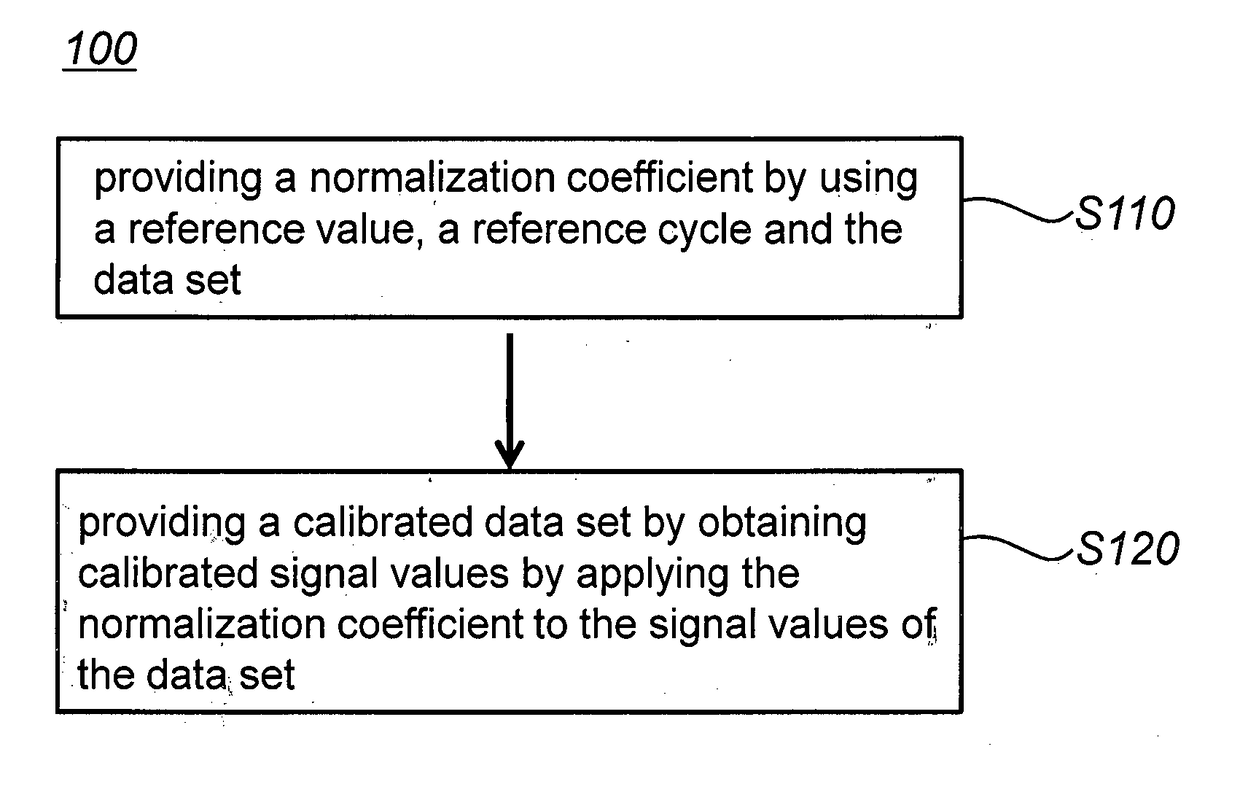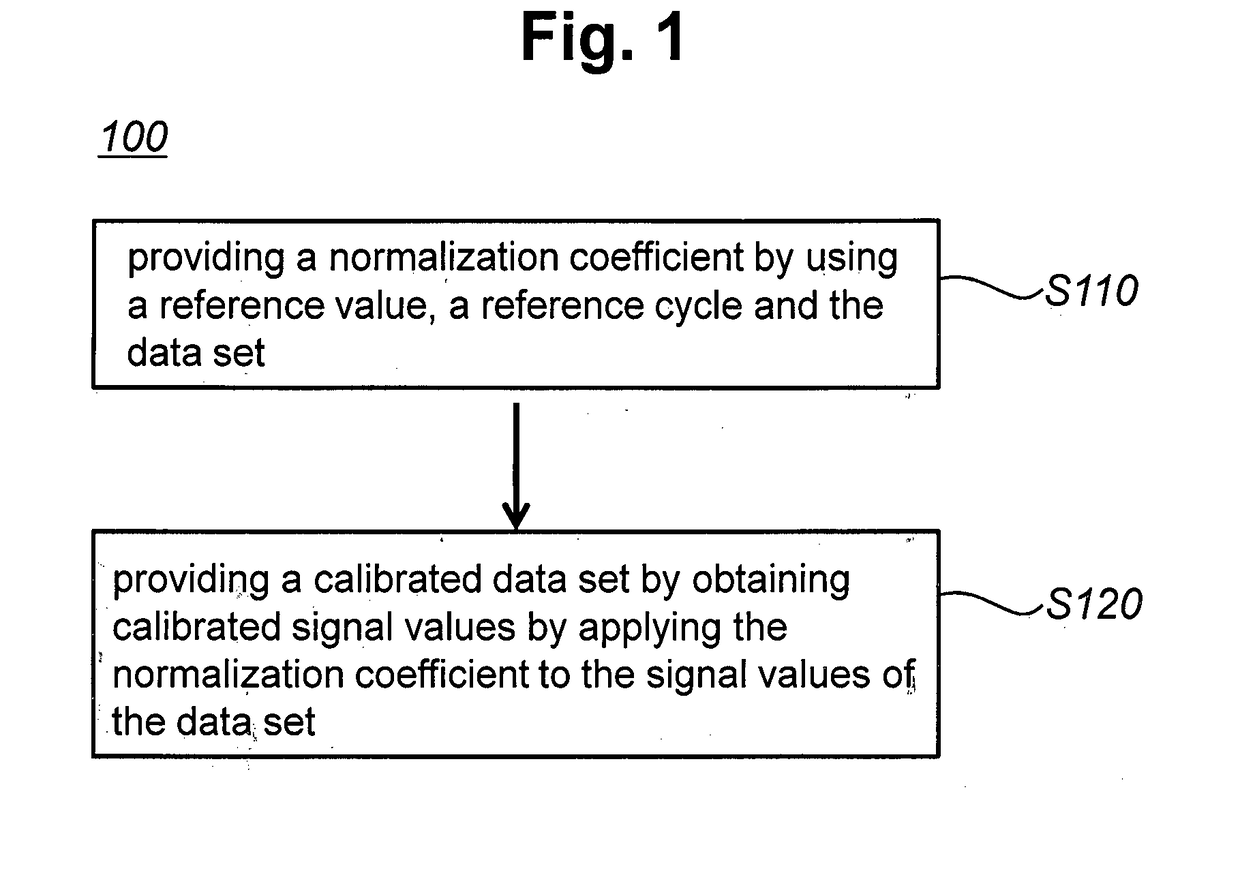Method For Calibrating A Data Set Of A Target Analyte
- Summary
- Abstract
- Description
- Claims
- Application Information
AI Technical Summary
Benefits of technology
Problems solved by technology
Method used
Image
Examples
example 1
on of Data Set by Using Specific Background Signal-Based Normalization (SBN) and Analysis of Calibrated Data Set
[0217]The method of controlling the input or output signal intensity in hardware-wise is widely used for minimizing the intra-instrument signal variations in a real-time PCR. For example, the output intensity of the light source (e.g., LED and Halogen lamp) is adjusted or the input intensity of the signal is controlled in the filter of a detector for calibration of signals.
[0218]In Examples, the Specific Background signal-based Normalization (SBN) method of the present invention was used for calibrating variations in the amplified signals of data sets.
[0219]The signal variations in the following three groups of data sets were compared and analyzed: (i) a group of data sets obtained from an instrument without a hardware adjustment; (ii) a group of data sets obtained from an instrument with a hardware adjustment; and (iii) a group of data sets software-wise calibrated by the...
example 2
on and Analysis of the Data Set by Using Instrument Blank Signal Subtraction and Specific Background Signal Based Normalization (IBS-SBN)
[0304]The calibration of the data sets using the SBN will be more accurate if a signal value corresponding to an Instrument blank signal is subtracted from the data sets. In this Example, the method of Instrument Blank signal Subtraction and Specific Background signal-based Normalization (IBS-SBN) was used for the calibration of the amplified signal variations.
[0305]The amplification signal variations in the following three groups of data sets were compared and analyzed: (i) a group of data sets obtained from an instrument without a hardware adjustment of Example ; (ii) a group of data sets obtained from an instrument with a hardware adjustment of Example ; and (iii) a group of data sets obtained by calibrating the data sets of Example software-wise by the IBS-SBN.
[0306] Measurement of Instrument Blank Signal
[0307]Raw data sets generally include b...
example 3
on and Analysis of the Melting Data Set by Using Instrument Blank Signal Subtraction and Specific Background Signal Based Normalization (IBS-SBN)
[0371]In the above Examples 1 and 2, the nucleic add amplification data sets were calibrated using the SBN or IBS-SBN. In Example 3, it is investigated whether the melting data sets can be calibrated software-wise by the present method.
[0372]The melting signal variations in the following three groups of data sets were compared and analyzed: (i) a group of melting data sets obtained from an instrument without a hardware adjustment; (ii) a group of melting data sets obtained from an instrument with a hardware adjustment; and (ii) a group of calibrated melting data sets obtained by calibrating the melting data sets software-wise using the IBS-SBN.
[0373] Preparation of Melting Data Sets
[0374]A melting analysis for a target nucleic add molecule was performed using a PTOCE assay as a signal-generating means with 50 cycles of an amplification in t...
PUM
| Property | Measurement | Unit |
|---|---|---|
| Fraction | aaaaa | aaaaa |
| Fraction | aaaaa | aaaaa |
| Fraction | aaaaa | aaaaa |
Abstract
Description
Claims
Application Information
 Login to View More
Login to View More - R&D
- Intellectual Property
- Life Sciences
- Materials
- Tech Scout
- Unparalleled Data Quality
- Higher Quality Content
- 60% Fewer Hallucinations
Browse by: Latest US Patents, China's latest patents, Technical Efficacy Thesaurus, Application Domain, Technology Topic, Popular Technical Reports.
© 2025 PatSnap. All rights reserved.Legal|Privacy policy|Modern Slavery Act Transparency Statement|Sitemap|About US| Contact US: help@patsnap.com



